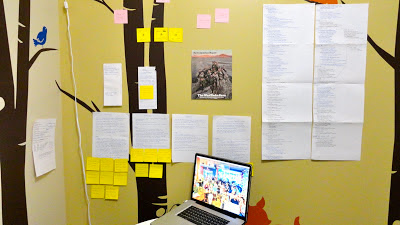Getting Back In
 |
| (At Interlochen, I stay in a room that’s decorated for a kid, hence the “forest” theme.) |
I’ve always been a list-taker, a note-maker, an organizer. When I hit the road for three years, part of what I found in writing studios across the country was a space to hang things on the wall. To be clear–I’d lived in places with plenty of wall space before and written well in them. But when your personal possessions are stripped down to what can fit into your car…
you’re not traveling with framed artwork. After a year or so of packing and unpacking my own writing supplies, I’d developed a system of keeping everything relatively small and transportable. Notes scribbled on old envelopes or the backs of first draft pages. Post-Its or discarded cardstock or grocery store receipts. I spread these things around the desk or kept them stuffed in a folder for access only when I thought I needed them. It wasn’t until seeing the bulletin boards at VCCA (for the second time) that it finally dawned on me that wall space was an invitation. I wrote about my epiphany in this essay, “In Praise of Bulletin Boards” and have been hanging notes on the wall ever since. Living with my notes physically around me, from wall to wall, completely changed my writing process because it enabled me to “live inside” the world I was making as I made it.
This weekend, I found that hanging my notes reminded me about what made my characters tick. I added four new sheets of paper (one for each of the main characters) with notes I’d compiled based on two critiques I received. These lists included general concerns for each character, followed by a list of suggestions to address the problem. For example, Nathan is just a little too decent. One reader suggested adding a scene where he snaps at his wife and then feels bad later. In the case of Aaseya, whose desires are too Westernized, a reader suggested lengthening the relationship Aaseya has with an American teacher from 6 months to 2 years and adding a full scene that depicts the strength of the teacher’s influence on Aaseya when she was a young girl. Surrounded by these new notes and my original intentions, the wall helped me see that I had informed choices to make. Rather than feeling overwhelmed by too many choices from a vast sea of fictional possibilities, I could see an emotional logic to the changes I needed to make…
So I sat down…
And started making them.

